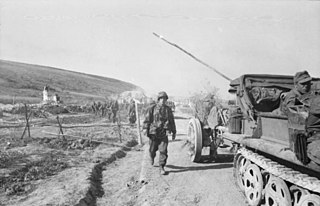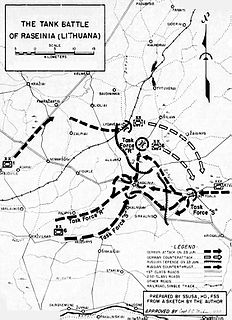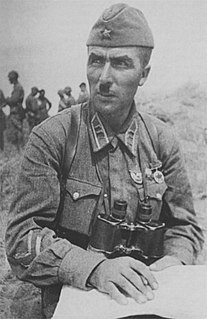
Operation Citadel was a German offensive operation against Soviet forces in the Kursk salient during the Second World War on the Eastern Front that initiated the Battle of Kursk. The deliberate defensive operation that the Soviets implemented to repel the German offensive is referred to as the Kursk Strategic Defensive Operation. The German offensive was countered by two Soviet counter-offensives, Operation Polkovodets Rumyantsev and Operation Kutuzov. For the Germans, the battle was the final strategic offensive that they were able to launch on the Eastern Front. As the Allied invasion of Sicily began, Adolf Hitler was forced to divert troops training in France to meet the Allied threats in the Mediterranean, rather than use them as a strategic reserve for the Eastern Front. Germany's extensive loss of men and tanks ensured that the victorious Soviet Red Army enjoyed the strategic initiative for the remainder of the war.
The 4th Mechanized Corps was a formation in the Soviet Red Army during the Second World War.
A mechanised corps was a Soviet armoured formation used prior to the beginning of World War II and reintroduced during the war, in 1942.

The Battle of Raseiniai was a large tank battle that took place in the early stages of Operation Barbarossa, the German invasion of the Soviet Union. The battle was fought between the elements of the German 4th Panzer Group and the Soviet 3rd Mechanized Corps with the 12th Mechanised Corps, in Lithuania, 75 km (47 mi) north-west of Kaunas. The Red Army tried to contain and destroy the German troops that had crossed the Neman River but was unable to prevent them from advancing.
The 20th Guards Motor Rifle Division was a formation of the Russian Ground Forces, originally formed within the Soviet Red Army as the 3rd Mechanised Corps.

The 90th Guards Rifle Vitebsk Division was an infantry division of the Red Army during World War II. Formed from the 325th Rifle Division in recognition of its actions during the winter of 1943, the division fought in the Battle of Kursk, the Belgorod-Khar'kov Offensive Operation, Operation Bagration, the Baltic Offensive, the Vistula–Oder Offensive, and the East Prussian Offensive.
The 1st Mechanized Corps was a mechanized corps of the Red Army during World War II, formed twice.

The 2nd Mechanised Corps was a formation in the Soviet Red Army during the Second World War. Initially formed in June 1940 in response the German victories of 1940 it was attached to the Odessa Military District, & attached to the 9th Army in the Odessa Fortified Region in Soviet Union It was under the command of Lieutenant General Iu. V. Novoselsky when the German Operation Barbarossa began in June 1941. It initially comprised the 11th and 16th Tank Divisions, & the 15th Mechanized Division.
The 43rd Army was a Red Army field army of World War II that served on the Eastern Front. Formed in late July 1941, the army fought in the Battle of Smolensk (1941). It was forced to retreat after German troops broke through in October 1941 and subsequently fought in the Battle of Moscow. The army then fought in the Rzhev-Vyazma Offensive. After the end of the offensive, the army held its positions and transferred to the Demidov area in late 1942. It fought in the Battle of Smolensk (1943). During the summer of 1944 the army fought in Operation Bagration. In the fall the army advanced into the Baltic region and fought in the Riga Offensive (1944) and the Battle of Memel. In 1945 the army fought in the East Prussian Offensive before being placed in reserve near the end of April. The 43rd Army was disbanded postwar in July 1946.
The 119th Rifle Division was an infantry division of the Red Army, formed three times.

The Red Army's 54th Army was a Soviet field army during the Second World War. It was first formed in the Leningrad Military District in August, 1941, and continued in service in the northern sector of the Soviet-German front until the end of 1944. It spent much of the war attempting to break the German siege of Leningrad, in which it helped to achieve partial success in January, 1943, and complete success one year later. During these operations the soldiers of the 54th served under five different commanders, most notably Col. Gen. I.I. Fedyuninsky in the winter of 1941–42. After helping to drive Army Group North away from Leningrad and into the Baltic states in the first nine months of 1944, the army was deemed surplus to requirements on the narrowing front, and was officially disbanded on the last day of the year.

The 422nd Rifle Division was formed for the first time as a standard Red Army rifle division late in 1941, after the Soviet winter counteroffensive had begun, but was soon re-designated. A second formation began in March, 1942, again in the far east of Siberia, until July, after which it was moved west to join the reserves of Stalingrad Front in August. It was the highest-numbered rifle division to see active service in the front lines during the Great Patriotic War. Over the course of the next six months, the division distinguished itself in both defensive and offensive fighting and earned its re-designation as the 81st Guards Rifle Division on the first day of March, 1943. The 422nd was never reformed.

The 81st Guards Rifle Division was an infantry division of the Red Army and the Soviet Army. It was formed after the Battle of Stalingrad from the 422nd Rifle Division in recognition of that division's actions during the battle, specifically the encirclement and the siege of the German forces in the city. The 81st Guards continued a record of distinguished service through the rest of the Great Patriotic War, and continued to serve postwar, as a rifle division and later a motor rifle division, until being reorganized as the 57th Separate Guards Motorized Rifle Brigade in 2009 in the Russian Ground Forces. Most of its postwar service was in the Soviet (Russian) far east, where it was originally formed as the 422nd.

The 64th Guards Rifle Division was created on January 19, 1943 from the 327th Rifle Division, in recognition of that division's distinguished combat record in the Second Siniavino Offensive and Operation Iskra. It was one of a relatively small number of formations raised to Guards status in the northern sector of the Soviet-German Front. As such, it was employed as an assault division in the subsequent fighting, particularly in the final defeat of the German forces before Leningrad, and the final offensive against Finland. The division ended the war in Lithuania, helping to contain the enemy forces trapped in the Courland Pocket, and went on to serve well into the postwar era, still in the Leningrad/St. Petersburg area.

The 319th Rifle Division was first formed in December 1941, as a standard Red Army rifle division, in the Moscow Military District, but after a month was redesignated as the 2nd formation of a pre-war division that had been destroyed and disbanded. Another 319th was formed in the summer of 1942 in the North Caucasus Military District while the German offensive was threatening the Soviet oilfields near Baku. This formation had a short and undistinguished career, seeing little combat, and was disbanded in December. A third and final 319th was formed in the autumn of 1943 in the northern part of the front. This unit gave very creditable service for the duration of the war, distinguishing itself in the fighting through the Baltic states, and completing its combat path in East Prussia. It continued to serve briefly into the postwar period.

The 346th Rifle Division began forming in late August, 1941, as a standard Red Army rifle division, in the Volga Military District. It was assigned to the 61st Army while both it and its Army continued to form up before moving to the front lines in December to take part in the winter counteroffensive south of Moscow. In September, 1942, it became part of the 5th Tank Army, and joined the offensive that encircled German Sixth Army at Stalingrad during Operation Uranus. During 1943 and early 1944 it continued to serve in the southern part of the front, taking part in the liberation of Crimea, before being transferred to the Baltic States region, serving in Latvia and Lithuania until February, 1945, when it was once again reassigned, this time to be part of the follow-on forces in the conquest of eastern Germany. The division ended the war with a distinguished service record, but was disbanded shortly after the German surrender.

The 379th Rifle Division was raised in 1941 as an infantry division of the Red Army, and served for the duration of the Great Patriotic War in that role. It began forming in August, 1941 in the Urals Military District. It first served in the winter counteroffensive west of Moscow, and later in the bitter fighting around the Rzhev salient, but was moved north late in 1942. It took up positions along the Volkhov River, mostly under command of the 8th Army, and continued to serve in this Army's battles near Leningrad until September 1943, when it was transferred to the 2nd Baltic Front, where it would stay for the remainder of its service. During this period the division served under many army and corps commands but mostly in the 3rd Shock Army. The division ended the war in Lithuania, helping to contain and reduce the German forces trapped in the Courland Pocket. By this time it was judged as being surplus to the Red Army's needs and in December 1944 its personnel were parceled out to help bring other units of the Front closer to establishment strength. The 379th officially disbanded on the first day of 1945.

The 417th Rifle Division was formed as an infantry division of the Red Army in the spring of 1942 and served in that role until after the end of the Great Patriotic War. Although it was formed in the Transcaucasus, unlike the 414th and 416th Rifle Divisions formed in about the same place at the same time it was never designated as a National division. After its formation it remained in service in the Caucasus under direct command of the Transcaucasus Front until the summer of 1942, when it was redeployed first to the Northern Group of Forces in that Front and then to the 9th Army. As German Army Group A retreated from the Caucasus in January, 1943 the division was reassigned to the 58th Army and a few months later to 37th Army in North Caucasus Front. In July it redeployed northward to join Southern Front, where it was assigned to the 63rd Rifle Corps in 44th Army in mid-September as the Front fought through south Ukraine, eventually reaching the land routes to the Crimea. It took part in the offensive that liberated that region in April and May, 1944, fighting in the 51st Army and winning both a battle honor and the Order of the Red Banner in the process. After the Crimea was cleared the 51st Army was moved far to the north, joining 1st Baltic Front. During operations in the Baltic states the 417th was further distinguished with the award of the Order of Suvorov. In March, 1945 it joined the Courland Group of Forces on the Baltic coast containing the German forces encircled in northwest Latvia. It ended the war there and was soon moved to the Ural Military District before being downsized to a rifle brigade. This brigade was briefly brought back to divisional strength during the Cold War.

The Battle of Nevel was a successful military operation conducted by the Red Army in the Pskov Oblast of western Russia and in northern Belarus during World War II, from October 6 to roughly December 16, 1943 although fighting persisted in the area into the new year.

The 33rd Guards Rifle Division was formed as an elite infantry division of the Red Army in May, 1942, based on the 2nd formation of the 3rd Airborne Corps, and served in that role until after the end of the Great Patriotic War. It was the second of a series of ten Guards rifle divisions formed from airborne corps during the spring and summer of 1942. It was briefly assigned to the 47th Army in the North Caucasus Front but was soon moved to the Volga Military District and saw its first action as part of 62nd Army in the fighting on the approaches to Stalingrad. It was withdrawn east of the Volga in September, but returned to the front with the 2nd Guards Army in December, and it remained in this Army until early 1945. After helping to defeat Army Group Don's attempt to relieve the trapped 6th Army at Stalingrad the 33rd Guards joined in the pursuit across the southern Caucasus steppe until reaching the Mius River in early 1943. Through the rest of that year it fought through the southern sector of eastern Ukraine as part of Southern Front and in the spring of 1944 assisted in the liberation of the Crimea, earning a battle honor in the process. The Crimea was a strategic dead-end, so 2nd Guards Army was moved north to take part in the summer offensive through the Baltic states and to the border with Germany as part of 1st Baltic Front. During the offensive into East Prussia the division and its 13th Guards Rifle Corps was reassigned to 39th and the 43rd Armies before returning to 2nd Guards Army in April. For its part in the capture of the city-fortress of Königsberg the 33rd Guards would receive the Order of Suvorov. In mid-1946 it was converted to the 8th Separate Guards Rifle Brigade.













